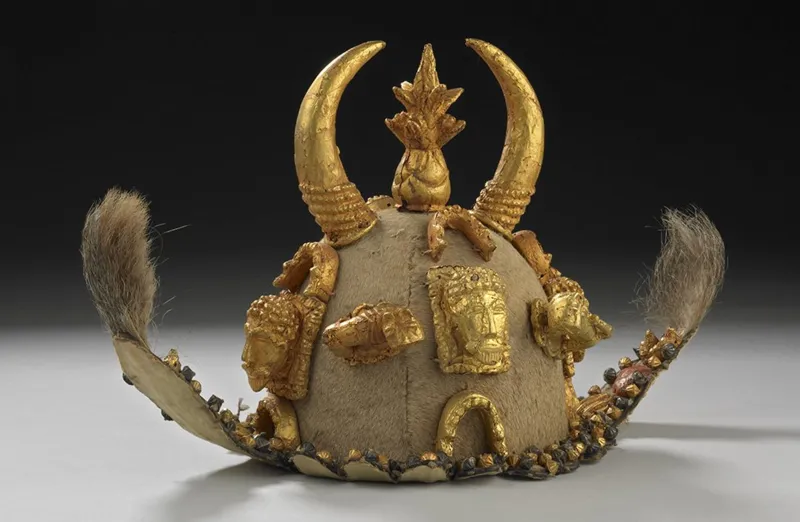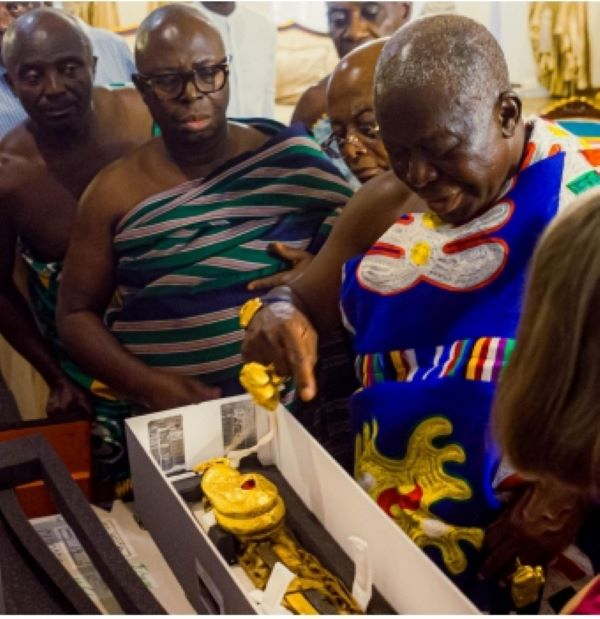You are using an out of date browser. It may not display this or other websites correctly.
You should upgrade or use an alternative browser.
You should upgrade or use an alternative browser.
Killmonger LIVES !!
- Thread starter get these nets
- Start date
More options
Who Replied?get these nets
Veteran
A pair of UK museums return gold and silver artifacts to Ghana under a long-term loan arrangement
January 25, 2024
LONDON (AP) — Two British museums are returning gold and silver artifacts to Ghana under a long-term loan arrangement — 150 years after the items were looted from the Asante people during Britain’s colonial battles in West Africa.
The British Museum and the Victoria & Albert Museum in London, together with the Manhyia Palace Museum in Ghana, on Thursday announced the “important cultural’’ collaboration, which sidesteps U.K. laws that prohibit the return of cultural treasures to their countries of origin. Those laws have been used to prevent the British Museum from returning the Parthenon Marbles, also known as the Elgin Marbles, to Greece.
Some 17 items in total are involved in the loan arrangement, including 13 pieces of Asante royal regalia purchased by the V&A at auction in 1874. The items were acquired by the museums after they were looted by British troops during the Anglo-Asante wars of 1873-74 and 1895-96.
“These objects are of cultural, historical and spiritual significance to the Asante people,’’ the museums said in a statement. “They are also indelibly linked to British colonial history in West Africa, with many of them looted from Kumasi during the Anglo-Asante wars of the 19th century.”
The items covered by the loan agreement represent just a fraction of the Asante artifacts held by British museums and private collectors around the world. The British Museum alone says it has 239 items of Asante regalia in its collection.
Nana Oforiatta Ayim, special adviser to Ghana’s culture minister, said the deal was a “starting point,” given British laws that prohibit the return of cultural artifacts. But ultimately the regalia should be returned to its rightful owners, she told the BBC.
“I’ll give an analogy, if somebody came into your house and ransacked it and stole objects and then kept them in their house, and then a few years later said, ‘You know what, I’ll lend you your objects back,’ how would you feel about that?” she said.
Last edited:
get these nets
Veteran
A pair of UK museums return gold and silver artifacts to Ghana under a long-term loan arrangement
January 25, 2024

LONDON (AP) — Two British museums are returning gold and silver artifacts to Ghana under a long-term loan arrangement — 150 years after the items were looted from the Asante people during Britain’s colonial battles in West Africa.
The British Museum and the Victoria & Albert Museum in London, together with the Manhyia Palace Museum in Ghana, on Thursday announced the “important cultural’’ collaboration, which sidesteps U.K. laws that prohibit the return of cultural treasures to their countries of origin. Those laws have been used to prevent the British Museum from returning the Parthenon Marbles, also known as the Elgin Marbles, to Greece.
Some 17 items in total are involved in the loan arrangement, including 13 pieces of Asante royal regalia purchased by the V&A at auction in 1874. The items were acquired by the museums after they were looted by British troops during the Anglo-Asante wars of 1873-74 and 1895-96.
“These objects are of cultural, historical and spiritual significance to the Asante people,’’ the museums said in a statement. “They are also indelibly linked to British colonial history in West Africa, with many of them looted from Kumasi during the Anglo-Asante wars of the 19th century.”
The items covered by the loan agreement represent just a fraction of the Asante artifacts held by British museums and private collectors around the world. The British Museum alone says it has 239 items of Asante regalia in its collection.
Nana Oforiatta Ayim, special adviser to Ghana’s culture minister, said the deal was a “starting point,” given British laws that prohibit the return of cultural artifacts. But ultimately the regalia should be returned to its rightful owners, she told the BBC.
“I’ll give an analogy, if somebody came into your house and ransacked it and stole objects and then kept them in their house, and then a few years later said, ‘You know what, I’ll lend you your objects back,’ how would you feel about that?” she said.
I find myself scratching my head when I hear of non-egyptian African art being hoarded in the west despite the request of its original owners to repatriate them for the consumption of African markets with genuine interest in them.
I have one main issue here. Is there really a demand for this art among white people? No seriously. I feel like they are hoarding it just for the sake of having it. I have serious doubts about its consumption.
Over my lifetime in the west I have acquainted myself with many white people on both sides of the Atlantic , and I cannot name a single one with a genuine interest in African art (beyond Egypt) . Even when visiting art galleries with an international twist, there are untold lines of white people queueing for their fellow white art pieces ranging from cromagnom cave drawings, to Greeks, to celts, to Romans, French, Italian, etc. There is a slightly smaller line for Asian art items(china, India, Japan, south east Asia, dutch, etc) , and the rest of the museum is ghost town with barely any interest in the rest of the world including Africa.
It just seems like such a waste to have these items being ignored among white people who are mostly indifferent to their existence.
get these nets
Veteran
I would disagree here. Traveling to Europe is almost a rite of passage for certain segments of whites in this hemisphere. There, they can see the preserved sites and artifacts from their or other European cultures....directly.I find myself scratching my head when I hear of non-egyptian African art being hoarded in the west despite the request of its original owners to repatriate them for the consumption of African markets with genuine interest in them.
I have one main issue here. Is there really a demand for this art among white people? No seriously. I feel like they are hoarding it just for the sake of having it. I have serious doubts about its consumption.
Over my lifetime in the west I have acquainted myself with many white people on both sides of the Atlantic , and I cannot name a single one with a genuine interest in African art (beyond Egypt) . Even when visiting art galleries with an international twist, there are untold lines of white people queueing for their fellow white art pieces ranging from cromagnom cave drawings, to Greeks, to celts, to Romans, French, Italian, etc. There is a slightly smaller line for Asian art items(china, India, Japan, south east Asia, dutch, etc) , and the rest of the museum is ghost town with barely any interest in the rest of the world including Africa.
It just seems like such a waste to have these items being ignored among white people who are mostly indifferent to their existence.
The continent of Africa is less accessible, and so is viewing sites and artifacts from African cultures directly.
Viewing curated elements of those Black cultures in American or European museums is their only access to it, so in effect it holds more value than the thousands of Euro pieces that they will view.
get these nets
Veteran
??I think what @CopiousX was asking is whether there is a demand to see this art at all? Good question, actually.
What are the two high profile museums in your metro area? Go look and see how many African art exhibits they had in the 5 years before Summer 2020, and that would give you an indication that there is a demand and audience for this among museum goers.
get these nets
Veteran
Currently, at the Met in NYC

 www.metmuseum.org
www.metmuseum.org
There are two exhibitions about African art.

&


Exhibitions - The Metropolitan Museum of Art
The Met presents more exhibitions than any art museum in the world with more than 30 exhibitions each year representing a wide range of artists, eras, and cultures.
There are two exhibitions about African art.

&

get these nets
Veteran
Feb 11, 2024

US museum returns Ghana's first batch of looted gold regalia
Representatives of the museum handed them over to the Asante king, Otumfuo Osei Tutu II, in the city of Kumasi.
get these nets
Veteran
May 3, 2024

Manhyia Palace Museum reopens in May 2024, showcasing restored treasures, international ties and expanded facilities
The Manhyia Palace Museum, Kumasi announces its reopening on 1st May 2024, as part of the Silver Jubilee celebrations of Otumfuo Osei Tutu II, Asantehene (Asante King).
get these nets
Veteran
02/23/25

The Netherlands Will Return 113 Benin Bronzes to Nigeria
The items were previously in the Dutch State Collection and is the single largest repatriation of Benin Bronzes.
trap101-ETHout-Allegri-In
Superstar
get these nets
Veteran
06/19/25
get these nets
Veteran
11/10/25


